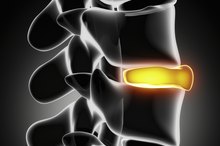Can You Feel Nausea After Chiropractic Care?
Chiropractors treat problems affecting your muscles, skeletal structure and nervous system. This type of therapy does not involve drugs or surgery, only the physical manipulation -- adjustment or realignment -- of your spine and neck by hand. The American Chiropractic Association says that chiropractic treatment is mostly safe. Yet, it admits that adverse effects are possible. Nausea is one such effect.
About Nausea
Nausea is a reaction in your stomach that manifests as an urge to throw up, but does not always lead to vomiting. Pregnancy and chemotherapy are two conditions that commonly cause nausea. Eating something that is not as fresh as you thought can also upset your stomach, causing nausea. Likewise, certain movements, like riding in a boat or car, may lead to the type of nausea known as motion sickness.
- Nausea is a reaction in your stomach that manifests as an urge to throw up, but does not always lead to vomiting.
Nausea and Chiropractic
How to Treat Nausea Caused by a Concussion
Learn More
A Danish study reported in the October 1997 issue of the “Journal of Manipulative and Physiological Therapeutics” concluded that nausea as a side effect of chiropractic treatment amounted to less than 5 percent of the adverse reactions experienced following spinal manipulation. Researchers, who conducted the study via patient interviews, said that the negative response was among those that were benign and physiological, but they did not seem to know why it occurred.
Treatment Safety
According to the National Center for Complementary and Alternative Medicine, minor temporary side effects are common from receiving chiropractic treatment. They usually include fatigue, headaches and soreness in the area of the body treated by the practitioner. The NCCAM also states that the more serious risk of vertebrobasilar artery stroke was studied over nine years in Ontario. Researchers concluded that chiropractic treatment did not pose a greater risk of stroke than conventional care by a traditional medical doctor.
- According to the National Center for Complementary and Alternative Medicine, minor temporary side effects are common from receiving chiropractic treatment.
- Researchers concluded that chiropractic treatment did not pose a greater risk of stroke than conventional care by a traditional medical doctor.
Considerations
Cymbalta Withdrawal Symptoms
Learn More
If your health insurance covers chiropractic visits, it may require that a physician prescribe the alternative treatment. The chiropractor may also ask for your primary care provider to rule out other conditions she is not prepared to treat before she starts working with you. Even if those scenarios do not apply to you, consider keeping your physician in the loop of your chiropractic treatment. Collaboration between both health care providers can only benefit you. If you experience long-lasting nausea after your chiropractic adjustment, for example, your family physician has a broader medical knowledge that comes in handy when troubleshooting gastrointestinal conditions.
- If your health insurance covers chiropractic visits, it may require that a physician prescribe the alternative treatment.
Related Articles
References
- Journal of Manipulative and Physiological Therapeutics; Side Effects of Chiropractic Treatment: A Prospective Study; 1997
- Cleveland Clinic: Diseases & Conditions--Nausea and Vomiting
- Branney J, Breen AC. Does inter-vertebral range of motion increase after spinal manipulation? A prospective cohort study. Chiropr Man Therap. 2014;22:24. doi:10.1186/s12998-014-0024-9
- Haas M, Spegman A, Peterson D, Aickin M, Vavrek D. Dose response and efficacy of spinal manipulation for chronic cervicogenic headache: a pilot randomized controlled trial. Spine J. 2010;10(2):117-28. doi:10.1016/j.spinee.2009.09.002
- Digiorgi D. Spinal manipulation under anesthesia: a narrative review of the literature and commentary. Chiropr Man Therap. 2013;21(1):14. doi:10.1186/2045-709X-21-14
- American Chiropractic Association. American Board of Chiropractic Specialties (ABCS).
- Margach RW. Chiropractic functional neurology: An introduction. Integr Med (Encinitas). 2017;16(2):44-45.
- Bryans R, Descarreaux M, Duranleau M, et al. Evidence-based guidelines for the chiropractic treatment of adults with headache. J Manipulative Physiol Ther 2011; 34: 274-89. doi:10.1016/j.jmpt.2011.04.008
- Centers for Disease Control and Prevention. Use of yoga, meditation, and chiropractors among U.S. adults aged 18 and over.
- National Center for Complementary and Integrative Health. Chiropractic: in depth. Updated April 2019.
- National Health Statistics Report. Trends in the use of complementary health approaches among adults: United States, 2002–2012. Updated February 10, 2015.
- University of Minnesota. Taking Charge of Your Health & Wellbeing. How can I find a qualified chiropractor?
Writer Bio
Emma Watkins writes on finance, fitness and gardening. Her articles and essays have appeared in "Writer's Digest," "The Writer," "From House to Home," "Big Apple Parent" and other online and print venues. Watkins holds a Master of Arts in psychology.









